If any supercar could define a decade, it was the flamboyant Testarossa and the 1980s.
The favourite of Thatcher’s bonus-laden deregulated bankers and celebrities alike, the Testarossa (literally “red head” in Italian) was a wide, wedged-shaped icon of the decade of excess.
Instantly recognisable from its “cheese grater” side strakes, the car was launched as a replacement for the BB 512 at the 1984 Paris Motor Show, initially selling in the UK for £62,666 – a drop in the ocean for yuppies with cash to burn and the likes of Elton John, Dr Dre and F1 driver Gerhard Berger.
Powered by Ferrari’s 5-litre flat-12, the Testarossa name was a throwback to the World Sportscar Champion of 1957, the 250 Testa Rossa, both cars so named because of their red-painted cam covers.
Styled by Pininfarina, aerodynamics expert Leonardo Fioravanti devised a shape so slippery its drag coefficient was just 0.36, significantly better than the Lamborghini Countach’s 0.42 – and all without the need for a massive rear spoiler.

The Testarossa proved a perfect fit for TV’s most vivid embodiment of 80s style, Miami Vice, and also featured in legendary video game OutRun, while more recently Leonardo DiCaprio drove one in stockbroker crime movie Wolf of Wall Street, set in the late 80s and early 90s.
But what was it like to drive? Well, the howling mid-mounted flat-12 produced 390bhp at 6300rpm, pushing the car from 0-60mph in 5.2 seconds and on to a claimed 180mph.
Car and Driver magazine described a rare black Testarossa as “like Darth Vader’s personal warship, and it drives civilians crazy. Their eyes widen three lanes away.”
“Never before has a car so rakish and so potent been so refined. The Testarossa’s flat twelve is smooth, tractable, and completely well mannered around town. Press hard on the throttle and it turns on the power like a well-oiled rheostat – albeit a very quick-acting one. The engine feels almost German in character – but you’d never mistake the origin of the shriek behind your ears.”
The Testarossa evolved into the 512TR and F512M between 1992 and 1996, with more than 10,000 sold in total; the high number produced makes the Testarossa relatively affordable today.
Finally, if you have a spare 20 minutes, take a detailed look and virtual drive in this comprehensive video review.

